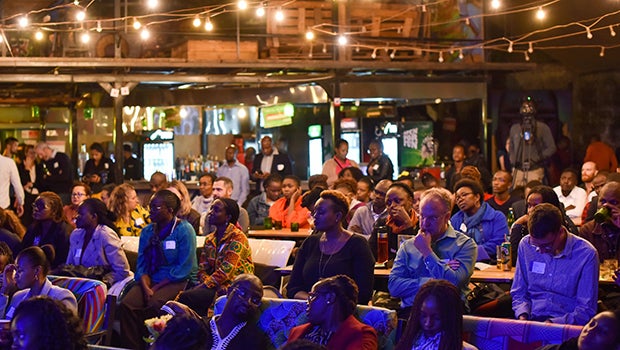Above, watch the full conversation featuring US Interior Secretary Sally Jewell at the Aspen Institute in Aspen, CO.
US Interior Secretary Sally Jewell likes to invoke the story of a little-known, rare western bird when she talks about a new era in conservation management.
The greater sage-grouse is at the center of a complex, years-long conservation process involving multiple stakeholder groups. As the overseer of agencies such as the US Fish and Wildlife Service and Bureau of Land Management, which are intimately involved in the process, it’s Jewell’s job to oversee the whole affair. And she’s doing it in a collaborative, inclusive manner that has never really been done before.
A former oil company engineer, banker, and CEO of REI from the Pacific Northwest, Jewell had never heard of the greater sage-grouse before being confirmed as secretary of the interior in April 2013. The odd-looking ground bird, about the size of a chicken with spiked tail feathers, is native to 11 western states throughout the Rocky Mountains and Great Basin, Jewell recently told an Aspen Institute audience as part of the Hurst Lecture Series in Aspen, CO.
The greater sage-grouse population has plummeted over the last 25 years or so — some accounts say by 98 percent — and the bird was nominated for listing under the Endangered Species Act under Jewell’s predecessor, Ken Salazar, in 2010. But while an endangered status was warranted, said Jewell, the agency determined it didn’t have the resources to protect the grouse, and instead launched a collaborative effort to address those challenges.
“What’s happened under the greater sage grouse initiative, the collective effort of 11 states, is nothing short of incredible,” said Jewell.
That process has involved ranchers, developers, oil and gas companies, conservationists, and local fire protection districts, in addition to a slew of local, state, and federal government agencies, plus varied private interests. All those diverse stakeholders would normally be at odds when it comes to negotiating their interests in the vast, flat sagebrush-covered lands that are essential sage-grouse habitat yet receive relatively little federal protection, and have become increasingly important for human uses such as energy and real estate development.
But, “people had to come together,” said Jewell, and sit down with each other to try to craft collaborative agreements that would protect both the greater sage-grouse and balance their interests. And they did so on a local and state level, even as Jewell spearheaded 14 separate plans to protect sage-grouse habitat on federal lands.
By the end of September, the Fish and Wildlife Service must make a determination as to whether to protect the greater sage-grouse under the Endangered Species Act, which many private interests fear will hurt their interests and economic development in general.
“If we work together, I’m optimistic we will have a ‘not-warranted’ listing, meaning the states will retain management, and ongoing development will be able to continue,” said Jewell. “And at the end of day, despite the fact that we will get sued — I’m used to it, we get handed about three lawsuits a week — I believe that because of this hard work, it will stand up to legal scrutiny and show a path that changes the future of conservation and the future of how we work together.”
This collaborative, inclusive decision-making is indicative of “a much more thoughtful approach [in the Interior Department] that I think will set a bar that I hope our successors will follow,” said Jewell, who lauded the efforts of government staffers who could be paid more in their respective private industries, but choose to work on these issues within government because of their passion for the mission. This despite the fact that government agencies are subject to shutdowns, cuts by congressional whims, and the type of rigorous oversight that discourages risk-taking, noted Jewell, who was explaining why the public sector can be so much more challenging than the private sector.
“We are in the forever business and we don’t even have a budget to last one year,” she lamented. “It’s crazy.”
Jewell’s focus on balance is playing out in energy extraction as well. As one of the few secretaries of the interior who has fracked a well, she pointed out that she understands the industry.
“Natural gas is an important source of energy, and it can be done safely and responsibly, but it must be regulated,” said Jewell, adding that her department has recently updated fracking regulations and stream protection rules. “You can’t stop all oil and gas so you have to think about a thoughtful balance.”
Jewell addressed two questions about the Thompson Divide, a booming natural gas drilling area near Aspen that is at the center of a major grassroots conservation effort. As with the greater sage-grouse, she touted the importance of all the vested interests sitting around a table and trying to come up with a path forward together.
“I never understood the saying before that all politics is local, and now I do,” she said. “Local voices are important. Community voices matter.”
Jewell is big on how technology can help with some of these land management issues. She cited advances in satellite imaging data that help measure groundwater and increasingly sophisticated maps that can be used as resources for various interests in land-use planning.
But Jewell was probably most excited about an Interior Department initiative to get American kids and youth into the great outdoors. Citing a study that found that screen time for American kids has risen to 56 hours per week, plus demographic shifts that are leading to a more urban, diverse population, Jewell said, “There is a growing lack of familiarity and comfort with the outdoors among our population. We have to study how we use the outdoors, and the way we used to do it isn’t working.”
Noting that Latino families gravitate toward city parks for large family gatherings, Jewell questioned the standard public campground model of individual sites with one picnic table surrounded by trees. She explained how the department is raising private-sector funding for the 21st Century Conservation Service Corps, to put youth to work on public lands. And she discussed a new program that gives all fourth graders a free pass to the country’s national parks, as well as a program in 50 US cities to connect kids in urban areas to public lands.
“We will get every kid in this country in our public lands,” Jewell concluded.

